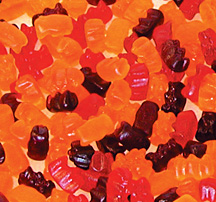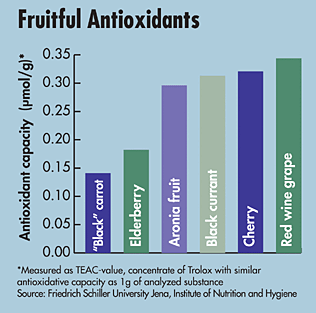
Fruits and vegetables are naturally rich in phytochemicals (e.g., anthocyanins and carotenoids), vitamins, fibers, minerals and other antioxidants and components. Nutrifood® extracts are liquid concentrates of fresh, ripe fruits and vegetables that are gently processed to maintain their native nutrients and phytochemicals, and they are now available from GNT USA, Inc., Tarrytown, NY.
“In a natural state, fruits and vegetables are comprised of 80% water. We remove the water, leaving behind solid materials such as minerals, proteins, carbohydrates, vitamins and other things naturally found in these products,” explains Stefan Hake, general manager. “However, we standardize the levels of anthocyanins and carotenoids to get consistent levels of phytochemicals.”
The Nutrifood line includes seven products: Complex (3g equals 1 cup of 10 different fresh fruits and vegetables); Arizona Sunset (3g equals 50g of fresh carrots and pumpkin); Earth's Harvest (3g equals 42g of fresh carrot; Sunshine (3g equals 60g of fresh pumpkin); Wildberries (1.6g equals 1 cup of fresh mixed red berries); Garden Delight (2g equals 100g of fresh tomatoes); and Vineyard's Select (1g equals 12 fl. oz. of grape juice or 4 fl. oz. of red wine). “We don't make antioxidants, nature does, but we make them available to our customers in a standardized form. Using ripe fruits and vegetables from our controlled harvests and a gentle process without chemical solvents is the key. What we offer is GRAS, not unknown substances,” states Hake.
Many processed foods do not contain phytochemicals, and while they may be highly-fortified, like cereals, they cannot offer all the health benefits that fresh fruits and vegetables do.

“Consumers are looking for nutritious foods, and want something that is natural and backed by scientific evidence,” says Chaudhry. Nutrifood products allow developers to make solid claims on their labels and to give consumers an exact level of phytochemicals they are ingesting (e.g., “This bagel contains 42.3mg of phytochemical content.”). Concentrations vary by application. Food formulators also have the choice of using equivalencies to fruit and vegetables on their labels (e.g., “This muffin has the same phytochemical content as a fresh, red ripe tomato: 100g.”).
For more information:
GNT USA Inc. at 914-524-0600 • info@gntusa.com Write in 201